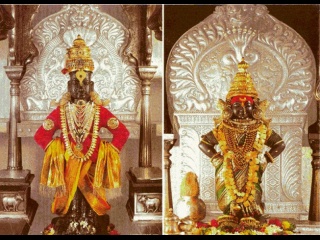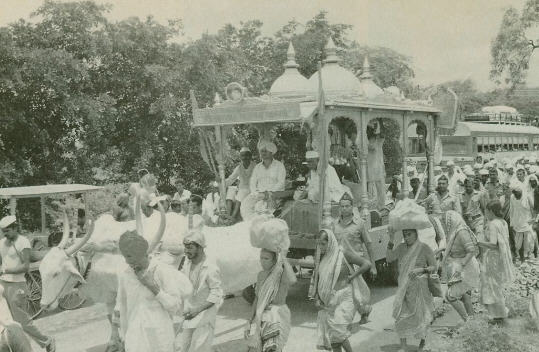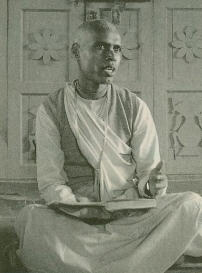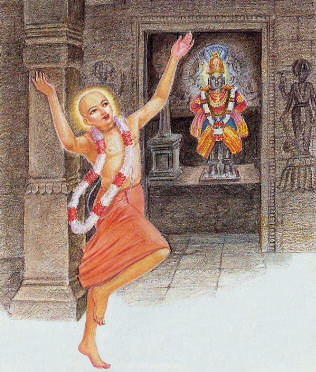Devoted pilgrims travel hundreds of kilometers and
wait all night to see their Lord for a few moments.
THROUGHOUT the provinces of India, the Supreme Lord is worshiped in various forms. In Andhra Pradesh He appears as Tirupati Balaji, in Kerala as Guruvayurappan, in Karnataka as the beautiful Udupi Krsna, in Gujarat as Dvarakadhisa and Ranacora Raya. And in Pandharpur, the spiritual capital of Maharashtra, the Lord is worshiped as Sri Vitthala. His devotees also fondly call Him Vithobha or Panduranga.
Pandharpur Dhama is located about four hundred kilometers southeast of Bombay. Some call it Bhu-vaikuntha, "the spiritual world on earth." Others call it Daksina Dvaraka, the Dvaraka of the South. The town is located on the western bank of the river Bhima. Because of the way the river bends as it reaches Pandharpur, it is known there as the Candrabhaga ("crescent moon"). For the devotees of Vitthala, this river is as holy as the Ganges.
Along the riverbank are fourteen ghatas, or bathing places. The main one is Maha Dvara Ghata. The short street that links this ghata to the eastern gate of the Vitthala temple is lined with shops and stalls selling tulasi, flower garlands, coconuts, incense, and sweets, all to offer to the Lord.
Temple and Deity Worship
The black stone temple hosts the five-thousand-year-old self-manifested Deity of Lord Vitthala. As one enters through the main door, one sees a deity of Sri Ganesa, to whom the Vitthala devotees pray to remove all obstacles to their worship.

Across the courtyard, up a few steps, one enters the darsana-mandapa, the hall where one can see the Lord. To proceed to the Deity room, visitors queue up through corridors built alongside the walls. Flanking the entrance of the Deity room are huge four-armed statues of Jaya and Vijaya, the doorkeepers of Vaikuntha, the spiritual world.
The slightly smiling, blackish-complexioned Deity of Sri Vitthala is three and a half feet tall. He stands on a brick, His hands resting on His hips. This posture reflects His pastimes in Pandharpur.
The Padma Purana and the Skanda Purana briefly describe why the Lord journeyed to Pandharpur and why He stays there in this form.
Once Srimati Radharani, Lord Krsna's consort in the village of Vrndavana, visited Dvaraka, where Lord Krsna lived as a king. At that time, Rukmini Devi, Lord Krsna's queen, noticed that Krsna was dealing more intimately with Radharani than He had ever done with her. Upset, she departed for the forest of Dindirvana, near Pandharpur.
Lord Krsna followed Rukmini to apologize, but His apology left her unmoved. So the Lord moved on to Pandharpur to visit one of His devotees, Bhakta Pundarika, now popularly known in Maharashtra as Pundalika.
When the Lord reached Pundarika's asrama, Pundarika was serving his elderly parents. So Pundarika gave the Lord a seat of brick and asked the Lord to wait. The Lord did as told. He stood, lotus hands on His hips, waiting for Pundarika to return.
While He was waiting, Rukmini, having forgotten her distress, came from Dindirvana and rejoined Him. Both of Them stayed in Pandharpur in Deity form. To this day the Lord stands on the same brick, but now He's waiting for all His devotees to come see Him.
While waiting, the Lord seems to tell the devotees, "Do not fear. For those who have surrendered unto Me, I have reduced the depth of the ocean of material suffering. See, it is only this deep."
He indicates the shallowness of the ocean by placing His hands on His hips.
Elegantly dressed in yellow and other colors, Lord Vitthala wears around His neck a vaijayanti garland and tulasi, whose aroma permeates the darsana hall and the surrounding area. His right hand holds a lotus flower and His left a conchshell. On His chest He bears the mark of Bhrgu's foot. His ears are decorated with shark-shaped earrings, and on His forehead beneath His crown is a broad mark of tilaka. The Lord's smile irresistibly enchants His devotees. Each pilgrim who approaches Him gets a glimpse of His peaceful smiling face and considers this the perfection of life.
The worship of Lord Vitthala begins with the mangala-arati ceremony at four o'clock in the morning. After arati the Lord is offered pancabhiseka, a bath with milk, yogurt, ghee, honey, and sugar water. At some point the bathing is interrupted so that the Lord may be fed butter mixed with sugar candy. A big lump of butter is literally put into His mouth. Then a short arati is offered, and the bathing resumes. After the bath, the Lord is meticulously dressed and profusely garlanded. Finally, He is offered a mirror in which to view His appearance.
As a token of His merciful nature, Lord Vitthala allows everyone to watch His bathing ceremony. After this the crowds, till then restrained along the walls of the darsana hall, are let into the sanctum sanctorum.
Daily, thousands of devoted pilgrims take darsana (seeing of the Lord). It is also the unique tradition in Pandharpur that everyone can go up to the altar and touch the lotus feet of the Deity. Some pilgrims even rest their heads upon His feet. But one has to move on quickly.
After taking darsana, pilgrims re-enter the darsana hall. Looking back, they get a last glimpse of the Lord's attractive form. In the buzzing atmosphere of the darsana hall they fall flat on the floor, offering obeisances. Then, holding each ear with the hand across from it, they turn about, springing up and down on the same spot, begging the Lord to forgive any offenses they may have committed at His lotus feet.
One of the pillars of the hall the Garuda Stambha represents Garuda, the eagle who serves as the carrier of Lord Visnu. Pilgrims embrace the pillar, with the prayer that toward the end of life Garuda will carry them back to Vaikuntha.
On the way out of the darsana hall, one sees hanging from the ceiling the famous eight prayers known as Pandurangastakam, composed by the acarya Sankara during his visit to Pandharpur in the eighth century. Each verse glorifies the beauty, qualities, and devotees of the Lord and ends with the refrain para-brahma-lingam bhaje pandurangam, meaning "I worship the supreme spiritual form of Lord Panduranga."
In the same temple compound, behind Lord Vitthala's shrine, stands the shrine of Srimati Rukmini Devi, the Lord's beautiful consort. Darsana, offerings, and aratis go on all day, except for a short break in the afternoon when the Deities rest. After the last arati, at eleven o'clock, the pujaris change the Lord's dress and chant special hymns asking Him to rest for the night.
Just as the Lord played the role of father and grandfather in Dvaraka, here too He reciprocates affectionately with His devotees. A famous painting depicts Him in a fatherly mood, carrying several devotees, some on His shoulders, some around His waist, and others holding His finger as they walk beside Him.
Devotees of Lord Vitthala
Some illustrious devotees of Lord Vitthala traveled widely throughout Maharashtra. Their preaching and their exemplary devotional mood left a permanent impression on the people. Their unanimous conclusive instruction to their followers was this: "Go on singing, go on dancing, and when you get to the lotus feet of the Lord, beg for love from Him." So nama-sankirtana, congregational chanting of the Lord's holy names, is very popular in Maharashtra.
In a letter dated July 30, 1977, Srila Prabhupada encouraged me in this way: "The whole of India and specifically your Maharashtra are enthused with Krishna. Now you have to revive their Krishna consciousness. This is Tukarama's country, but now they are becoming bad politicians. So revive them by the process of the sankirtana movement."

Pilgrims Sings Praises to Lord Vitthala
Saint Tukarama was the most famous of all Maharashtrian saints. He lived during the seventeenth century, and over the last three hundred years his devotional influence has been deeply felt by the local people. His poems, the 4,500 verses known as theAbhangas, have become part of the public memory of Maharashtra. They are sung in every village and every home.
Tukarama preached throughout his life, exhorting his countrymen to take to the path of bhakti, devotional service. His language was so simple and down to earth that even the most simple villagers understood it completely. He is the main force behind the continuous kirtanas and bhajanas performed at the many festivals in Pandharpur.
In his autobiography, Tukarama says he was initiated in a dream by Raghava Caitanya Kesava Caitanya. Though not everyone agrees, Gaudiya Vaisnavas (such as the ISKCON devotees) understand this to mean Sri Caitanya Mahaprabhu.
As Srila Prabhupada comments (Caitanya-caritamrta, Madhya 9.282, purport), "The sankirtana party belonging to Tukarama is still very popular in Bombay. [It] exactly resembles the Gaudiya Vaisnava sankirtana parties, for they chant the holy name with mrdanga and karatalas." They also wear neck beads and tilaka similar to those of the Gaudiya tradition.
Tukarama Acarya was a great devotee of Lord Vitthala. As mentioned before, the Deity is self-manifested. That is, He spontaneously appeared, without being carved and installed. Expressing full faith in this Deity of Lord Vitthala, Tukarama wrote, "If anyone says that this Deity was once installed, his mouth will be filled with worms."
Saint Tukarama sometimes had to suffer humiliation and opposition from envious people, but he always stayed more humble than a blade of grass, thus changing the hearts of his enemies. The saint left for the spiritual world in his selfsame body while engaged in nama sankirtana, chanting of the holy names of the Lord, with the residents of his home village. The villagers attested they saw a spiritual airplane descend and saw Tukarama board the plane and leave for the spiritual sky.
Another exalted spiritual leader among Lord Vitthala's devotees was Jnanesvara, who lived in the thirteenth century. At the age of sixteen, he translated the complete text of Bhagavad-gita into simple Marathi, the language of Maharashtra. His work is known as Jnanesvari. He attained samadhi (passed away) at the age of twenty-one.
Also famous is the life of Saint Namadeva. Once when Namadeva was a young boy, his father, who worshiped a Deity of Lord Vitthala at home, went out, leaving Namadeva in charge of the Deity. When the time came to offer food to the Lord, Namadeva prepared a plate, placed it on the altar, and sat down, begging the Lord to accept the offering. Following his father's advice to give the Lord some time to eat before taking back the plate, Namadeva left the Deity room and patiently waited, expecting the Lord to literally eat up the food. From time to time the boy would check, but the Lord seemed to be standing still.
After quite some time had passed and Namadeva saw no sign that the Lord would ever eat, Namadeva decided to intervene. Entering the Deity room, he appealed to Lord Vitthala, insisting that the Lord eat right away. And if He wouldn't, the boy threatened, he would smash his own head against the wall. To the boy's surprise, Lord Vitthala then took His lotus hands off His hips and physically ate the offering.
Dindi Procession: 200,000 Pilgrims
The most outstanding display of the Maharashtrians' devotion to Lord Vitthala is the Dindi Yatra, a pilgrimage on foot that culminates in Pandharpur. It has been performed annually for the last seven hundred years.
In fact, every month at Pandharpur on Sukla Ekadasi (the eleventh day of the waxing moon), a festival is held that attracts a large number of pilgrims. But, four of these festivals are especially large. And the main one, Dindi Yatra the huge Asadhi Ekadasi festival draws a crowd of 700,000 people. As many as 200,000 come on foot. The festival falls during the month of Asadha (July) and marks the beginning of Caturmasya, the four months of the rainy season. According to the Padma Purana, on that day the Lord goes to sleep for four months. When He wakes up, at the end of the month of Karttika, another festival is held, the second biggest.
For each of these festivals, pilgrims come from all the districts of Maharashtra and from other provinces of India like Gujarat, Karnataka, and Andhra Pradesh. The pilgrims follow in the footsteps of their many saints and spiritual leaders. Many of the pilgrims are varkaris.
The word varkari combines the words vari and kari, the former standing for the regular trip to Pandharpur, the latter meaning the one who does it. Varkari thus means "one who journeys to Pandharpur at a specific time in the year." Varkaris vow to visit Pandharpur every month, or at least once a year, during an Ekadasi festival.
The varkaris form well-organized and disciplined processions called Dindis, which start off from the birthsites and samadhi places of various saints and converge in Pandharpur. The pilgrims travel 150 to 300 kilometers, depending on where they start. The biggest of all Dindis is that of Jnanesvara, which forms a gigantic procession. It originates in Alandi, near Pune, and covers about 250 kilometers in an eighteen-day walk. Some of the smaller groups are on the road for about a month. Many more come by bus and train.
The men on the procession, dressed alike in white dhotis, kurtas, and typical Gandhi hats, walk in lines of six or seven abreast. They beat small brass cymbals, called tal, in such a perfect rhythm that even when several hundred play, it sounds like one person alone. In the front, several men carry saffron flags. Next, a group of men on each Dindi carry a decorated palanquin (palaki) bearing symbolic footprints (padukas) of the saint they follow. The leader of the group walks at the back, playing the vina,accompanied by one or more drum players.
Behind the men follow the women, dressed in bright colorful saris. Some carry tulasi plants in decorated pots on their heads. Others carry pots with water to serve their fellow varkaris.
Fifty to five hundred people walk in each Dindi group. Responding heartily to their kirtana leaders, they sing the mantras jaya jaya vithobha rukhumai! jaya jaya vithobha rukumai! and jaya jaya rama krsna hari, interspersed with lively songs glorifying Lord Vitthala.
Day after day, undaunted by heat or rain, the pilgrims fill the air with tumultous chanting. Sometimes they dance and sometimes run, rushing ecstatically towards Pandharpur and their Lord. In the midst of this procession the words spoken by the Lord in the Padma Purana come alive:
tatra tisthami narada
yatra gayanti mad-bhaktah
"O Narada, I stay where My devotees glorify Me."
Each Dindi is supported by vehicles trucks and bullock carts carrying crews ahead to cook and set up tents. When the pilgrims stop to rest and have their meals, each group finds its supporting crew just as calves recognize their mothers in the midst of a herd.

Pilgrims Arrive to Pandharpur
No one goes hungry on Dindi. The bigger groups cook in gigantic pots and distribute prasadam to anyone who sits in the line. The government supplies water for drinking and bathing.
The walkers reach their day's destination by late afternoon. The convergence of pilgrims, and the symbolic presence of their saints, awakens the sleepy villages with intense religious fervor. In the evening, groups everywhere perform kirtana, and crowds of thousands listen to various speakers, who spice their discourses with songs of the saints, to the tune of musical instruments. These speakers are like one-act players. They entertain and involve their audience, inspiring them to sing along.
On Dindi everything is done collectively. Crowds are cooking, crowds sitting in lines for prasadam, crowds sleeping side by side, crowds moving around, crowds queuing up for darsana in the temples along the way, crowds meeting the calls of nature in the fields…. You're never alone on Dindi.
The dense crowd stretches many kilometers, people walking ahead or struggling in the back to keep up. Many people independently follow the Dindi, carrying their few belongings upon their heads. Some begin walking as soon as they get up, as early as 2 A.M. The main group starts at 6:30.
Walking about fifteen kilometers a day, the Dindis finally reach the outskirts of Pandharpur and unite at Wakhari, a small village three kilometers away. On the eve of the Asadha Ekadasi, still more people join for the last leg of the pilgrimage. The three-kilometer stretch from Wakhari to the holy town of Pandharpur turns into a river of humanity flowing towards the ocean of mercy at the Lord's lotus feet. In his writings, Bilvamangala Thakura warns travelers passing through Pandharpur, "Do not walk on the bank of the river Bhima. A bluish-black person stands there, and even though His hands rest peacefully on His hips, He is expert at stealing the heart of anyone who sees Him."
It seems that the varkaris carefully ignore Bilvamangala Thakura's advice. In fact, they are especially eager to meet that person.
Upon reaching Pandharpur, the pilgrims take a dip in the Candrabhaga River. Then, carrying the palanquins on their shoulders, they perform nagara-pradaksina, walking a circle around the holy town. The circle complete, they queue up all night at the temple to catch a glimpse of Lord Vitthala on the Ekadasi day. In the heavy rush, each will get to see the Lord for perhaps a few seconds. For them it will be enough: their souls will be satisfied, and it will have been worth the trouble.
Lokanath Swami, a native of Maharashtra, grew up near Pandharpur. He leads ISKCON's worldwide Padayatras, or walking pilgrimage parties.
Pilgrims From Abroad

LOKANATH SWAMI: Amongst the multitude of pilgrims on Dindi Yatra, a pilgimage on foot that culminates in Pandharpur, there are always a few visitors from abroad, their eyes and ears wide open in amazement.
In 1989, some fifty fortunate ISKCON devotees, about a dozen of them foreigners, took part in the Dindi with Padayatra India, our own traveling party. All of us were treated nicely, without discrimination. Our saffron-robed party sparkled amidst the white dhotis and kurtas of the varkaris (pilgrims to Pandharpur). The Vitthala devotees would greet us Krsna devotees with a friendly "Hare Krsna."
Many people were impressed by our strict following of the Vaisnava principles. The varkaris, most of them householders, are devoted and very faithful to Lord Vitthala, but for lack of a living example to follow they sometimes still have a few attachments, such as tea, onions, and bidis (leaf-rolled cigarettes). So they saw our devotees as real renunciants. Varkaris would often dive to touch our devotees' feet.
A constant flow of pious souls would encircle the Padayatra Deity cart, eager for darsana, thrusting hands towards the pujari for maha-prasada and caranamrta, the water from the bathing of the Deity. But it wasn't rare to see a man wearing tilakatake off his shoes to receive the sacred caran-amrta with his right hand while holding a bidi in his left.
Dr. Thomas J. Hopkins, chairman of the Department of Religious Studies at Franklin and Marshall College, in Lancaster, Pennsylvania, relates his experience of Dindi: "Pandharpur is pervaded by much of the same quality of genuine devotion to Krsna that you find in a place like Vrndavana. There's a simple, popular movement there [Dindi] which draws people from a very wide range of backgrounds college professors, professional people, peasants from farms all brought together in a conscious community of believers. You really see the power of devotion break through all these ordinary barriers of caste and education and bring people together for worship.
"When I was there in 1969 during the festival period … both of us Westerners there at that festival were welcomed with open arms. There was no question of separation or difference due to caste or nationality…. The association of genuine devotees can exert a powerful effect upon one's consciousness. I can still not just remember but almost hear the singing of certain devotees at Pandharpur."
Iskcon At Pandharpur
ACROSS THE Candrabhaga River, right on the bank, rests a small and peaceful Hare Krsna asrama, started by ISKCON devotees from Maharashtra in the early 1980's. They cultivate the land, keep cows, and during Ekadasi festivals help serve the pilgrims. The devotees supply Srila Prabhupada's Marathi Bhagavad-gita, always popular.
The ISKCON asrama served as host for our Padayatra's first visit to Pandharpur, in December of 1984. During that visit, the priests of the Vitthala temple warmly welcomed us and gave us the special privilege of bathing the Deity of Lord Vitthala.
We were on a pilgrimage of our own to celebrate the appearance of Lord Caitanya Mahaprabhu five centuries before. So we installed symbolic footprints of Lord Caitanya under a huge pipal tree on the ISKCON property, commemorating Lord Caitanya's visit to Pandharpur.
Caitanya Mahaprabhu's Visit

LORD CAITANYA VISITED Pandharpur while on a journey through South India, apparently to search for His sannyasi brother, Sankararanya, formerly known as Visvarupa.
After traveling down the east coast of India through the province of Tamil Nadu and up the west coast through Kerala and Karnataka, Caitanya Mahaprabhu entered Maharashtra. As stated in the Caitanya-caritamrta (Madhya 9.282-283), the Lord went to Pandharpur, where He happily saw the Deity of Lord Vitthala and chanted and danced.
In Pandharpur Lord Caitanya met Sri Ranga Puri, a Godbrother of His spiritual master, Isvara Puri. They talked about Lord Krsna continuously for five to seven days.
Sri Ranga Puri recalled that he had once been to Navadvipa, Lord Caitanya's birthplace, where he had visited the house of a brahmana named Jagannatha Misra. Sri Ranga Puri remembered the taste of a curry cooked from banana flowers by Jagannatha Misra's wife. Jagannatha Misra's eldest son had accepted the renounced order. Sri Ranga Puri had later learned, he said, that this son had passed away in Pandharpur.
Jagannatha Misra, Lord Caitanya then revealed, had been His father, and the son who had passed away had been His brother.
Lord Caitanya stayed four more days in Pandharpur, before moving on. During His tour of South India, Lord Caitanya was constantly on the move, but He stayed in Pandharpur for about eleven days. His pastimes there, and those of His brother, establish yet another link between Pandharpur and the Gaudiya Vaisnava tradition followed by the present-day Hare Krsna devotees.
